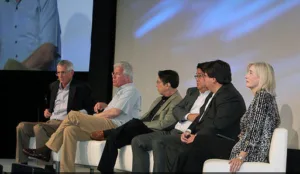The SMPTE-organized Technology Summit on Cinema at NAB kicked off with a panel on the lessons learned in the transition from film to digital. Here, panels noted that the idea of moving to digital film delivery really started to be taken seriously back in 1995, so 20 years ago. For the next five years, SVGA resolution class projectors from Texas Instruments, JVC and Sony were shown to the Hollywood community, who saw potential in the technology. In 1999, Star Wars Episode II was shown at four theaters in digital, which accelerated the activity going forward.
Soon, the Digital Cinema Initiative (DCI) was formed to help guide the development of standards for the roll out of digital projection. More projectors with around 1K resolution were built and deployed and by 2005, it was clear that resolution of 2K was the minimum to meet the needs of Hollywood. 2005 also coincided with the first digital 3D screenings. While the ability to show 3D with digital projectors had been discussed, few anticipated that this would soon drive the adoption of digital in theaters as exhibitors were able to deploy a single projector, charge more money for the 3D and actually make a profit. The development of the Virtual Print Fee model also enabled wider deployment to begin in earnest after this.
While the financial crisis that started in late 2008 slowed roll outs, they reached their peak in 2010 with hundreds of projectors being installed in theaters per month on a worldwide basis. Over the last five years, some of the benefits of these digital platforms have begun to be explored as well. This includes the ability to deliver alternative content in time periods when demand for movies is slower, high frame rate, personalized audio and now laser projection, which can allow high brightness 3D presentation.
The panel noted that overall the expense of operating the theater has not changed much during this transition, with staffing levels remaining about the same. But they have been able to deploy this staff in more customer-focused activities. On the other hand, there has been an increase in back-of-house as well as general and administrative costs, mainly attributable to VPN administration.
Exhibitor chain Carmike ignited the boom in 2005 when they purchased 2300 DLP projectors fearing they would not have access if they waited. These projectors are still in use, said the company and they might get 15 years of life from them, not as good as the 30 years film projectors offered.
On the production and distribution side, life is different as well. Digital technology has allowed more features and capabilities in film making, but versioning has grown tremendously. It is not unusual to have 60 English language versions of a major theatrical release and over 200 with different audio tracks. And, last minute changes come later and later in the production cycle, which digital can handle, but film could not.
Analyst Comment
Overall, the panel thought they have done a good job in the digital transition, but that it took longer than they thought. Plus, there is much more coming to keep things interesting.

